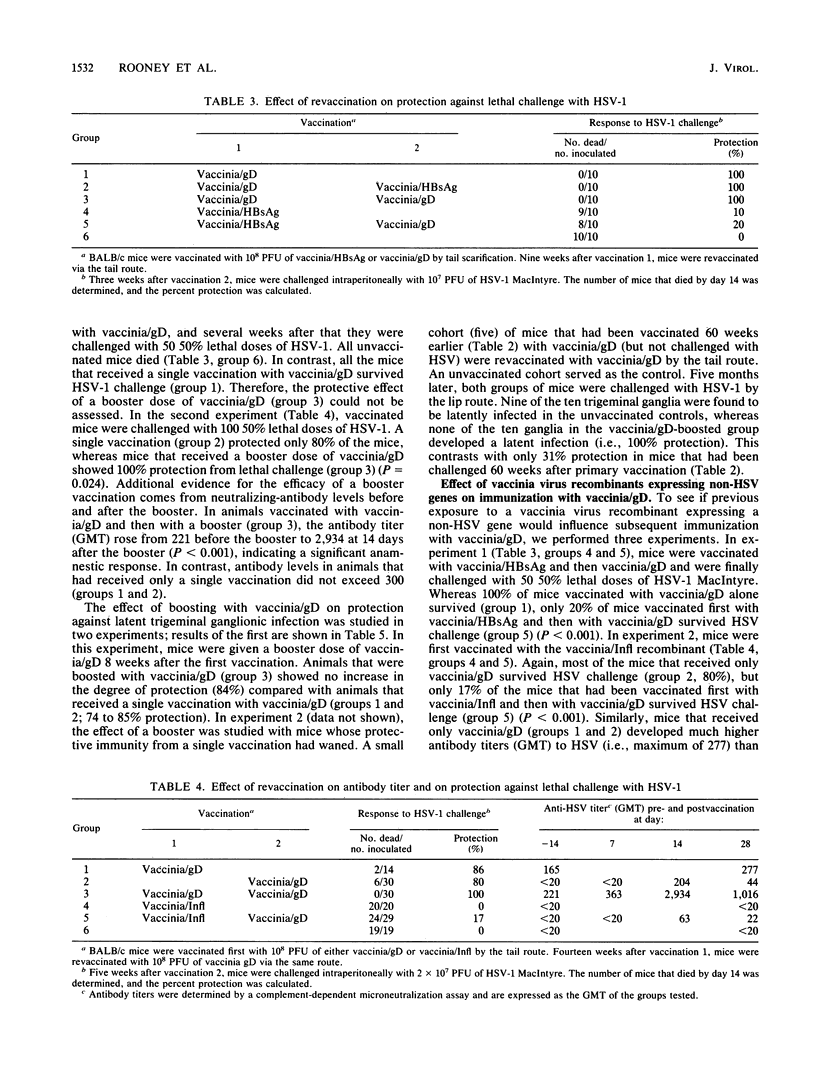Abstract
Previously we showed that mice immunized with a vaccinia virus vector expressing the herpes simplex virus type 1 (HSV-1) glycoprotein D (gD) gene (vaccinia/gD) were protected against both lethal and latent infections with HSV-1 for at least 6 weeks after immunization (K. J. Cremer, M. Mackett, C. Wohlenberg, A. L. Notkins, and B. Moss, Science 228:737-740, 1985). In the experiments described here, we examined long-term immunity to HSV following vaccinia/gD vaccination, the effect of revaccination with vaccinia/gD, and the impact of previous immunity to vaccinia virus on immunization with the gD recombinant. Mice immunized with vaccinia/gD showed 100, 100, and 80% protection against lethal infection with HSV-1 at 18, 44, and 60 weeks postimmunization, respectively. Protection against latent trigeminal ganglionic infection was 70, 50, and 31% at 6, 41, and 60 weeks postvaccination, respectively. To study the effect of reimmunization on antibody levels, mice vaccinated with vaccinia/gD were given a second immunization (booster dose) 3 months after the first. These mice developed a 10-fold increase in neutralizing-antibody titer (221 to 2,934) and demonstrated a significant increase in protection against lethal HSV-1 challenge compared with animals that received only one dose of vaccinia/gD. To determine whether preexisting immunity to vaccinia virus inhibited the response to vaccination with vaccinia/gD virus, mice were immunized with a recombinant vaccinia virus vector expressing antigens from either influenza A or hepatitis B virus and were then immunized (2 to 3 months later) with vaccinia/gD. These mice showed reduced titers of neutralizing antibody to HSV-1 and decreased protection against both lethal and latent infections with HSV-1 compared with animals vaccinated only with vaccinia/gD. We conclude that vaccination with vaccinia/gD produces immunity against HSV-1 that lasts over 1 year and that this immunity can be increased by a booster but that prior immunization with a vaccinia recombinant virus expressing a non-HSV gene reduces the levels of neutralizing antibody and protective immunity against HSV-1 challenge.
Full text
PDF




Selected References
These references are in PubMed. This may not be the complete list of references from this article.
- Gillespie J. H., Geissinger C., Scott F. W., Higgins W. P., Holmes D. F., Perkus M., Mercer S., Paoletti E. Response of dairy calves to vaccinia viruses that express foreign genes. J Clin Microbiol. 1986 Feb;23(2):283–288. doi: 10.1128/jcm.23.2.283-288.1986. [DOI] [PMC free article] [PubMed] [Google Scholar]
- JOKLIK W. K. The purification fo four strains of poxvirus. Virology. 1962 Sep;18:9–18. doi: 10.1016/0042-6822(62)90172-1. [DOI] [PubMed] [Google Scholar]
- Mackett M., Arrand J. R. Recombinant vaccinia virus induces neutralising antibodies in rabbits against Epstein-Barr virus membrane antigen gp340. EMBO J. 1985 Dec 1;4(12):3229–3234. doi: 10.1002/j.1460-2075.1985.tb04070.x. [DOI] [PMC free article] [PubMed] [Google Scholar]
- Mackett M., Yilma T., Rose J. K., Moss B. Vaccinia virus recombinants: expression of VSV genes and protective immunization of mice and cattle. Science. 1985 Jan 25;227(4685):433–435. doi: 10.1126/science.2981435. [DOI] [PubMed] [Google Scholar]
- Moss B., Flexner C. Vaccinia virus expression vectors. Annu Rev Immunol. 1987;5:305–324. doi: 10.1146/annurev.iy.05.040187.001513. [DOI] [PubMed] [Google Scholar]
- Paoletti E., Lipinskas B. R., Samsonoff C., Mercer S., Panicali D. Construction of live vaccines using genetically engineered poxviruses: biological activity of vaccinia virus recombinants expressing the hepatitis B virus surface antigen and the herpes simplex virus glycoprotein D. Proc Natl Acad Sci U S A. 1984 Jan;81(1):193–197. doi: 10.1073/pnas.81.1.193. [DOI] [PMC free article] [PubMed] [Google Scholar]
- Perkus M. E., Piccini A., Lipinskas B. R., Paoletti E. Recombinant vaccinia virus: immunization against multiple pathogens. Science. 1985 Sep 6;229(4717):981–984. doi: 10.1126/science.2992092. [DOI] [PubMed] [Google Scholar]
- Smith G. L., Mackett M., Moss B. Infectious vaccinia virus recombinants that express hepatitis B virus surface antigen. Nature. 1983 Apr 7;302(5908):490–495. doi: 10.1038/302490a0. [DOI] [PubMed] [Google Scholar]
- Smith G. L., Murphy B. R., Moss B. Construction and characterization of an infectious vaccinia virus recombinant that expresses the influenza hemagglutinin gene and induces resistance to influenza virus infection in hamsters. Proc Natl Acad Sci U S A. 1983 Dec;80(23):7155–7159. doi: 10.1073/pnas.80.23.7155. [DOI] [PMC free article] [PubMed] [Google Scholar]


